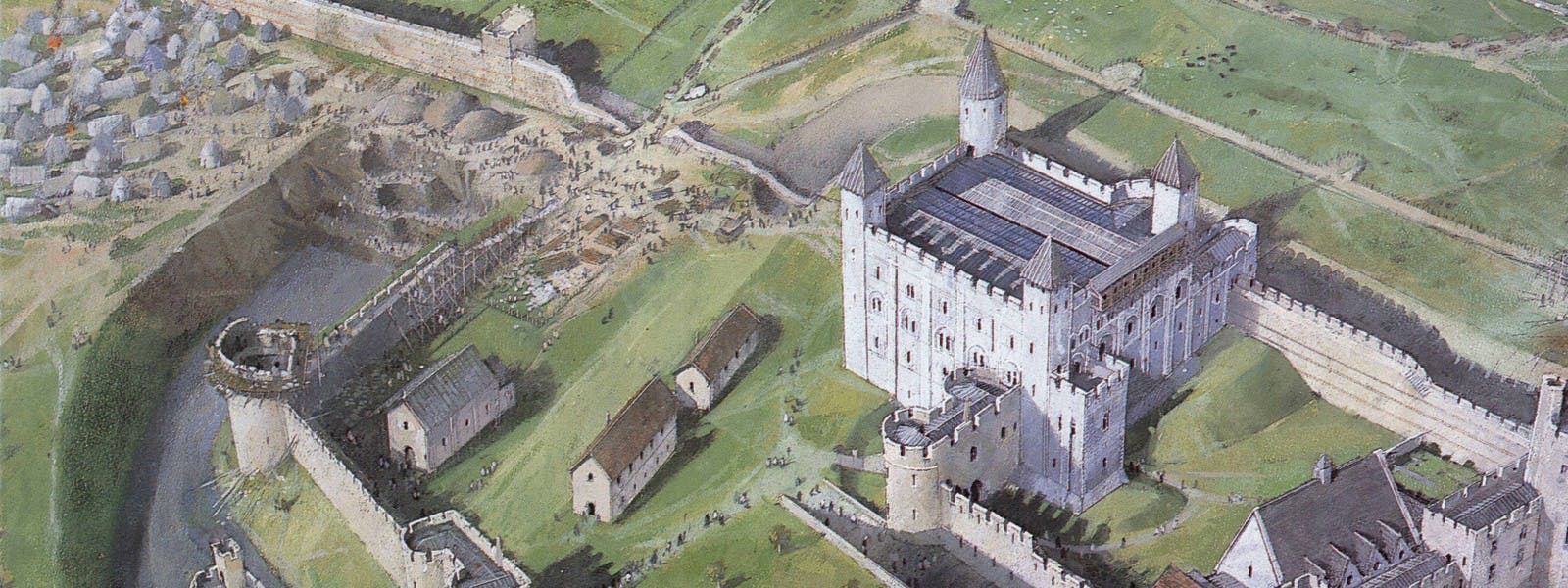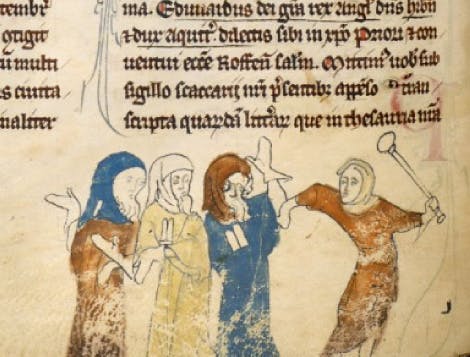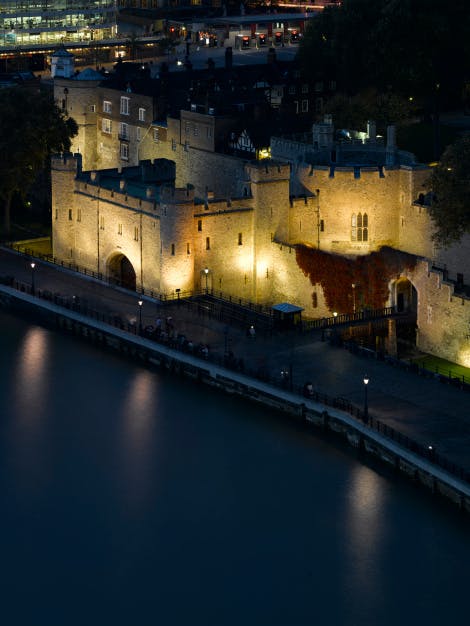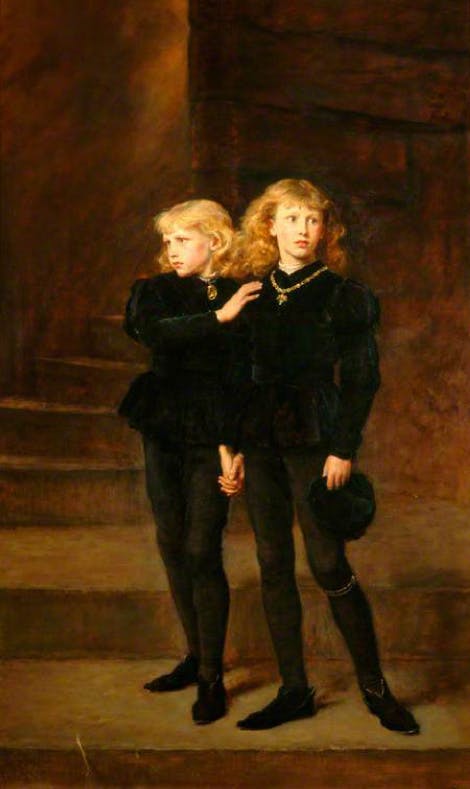
The Tower of London holds a principal place in the complex story of England's Medieval Jewish community. Medieval Jews sought refuge from anti-Jewish attacks at the Tower, but they also experienced it as a place of imprisonment, persecution, and execution.
The Tower was one of the main sites from which England’s Jews were expelled in 1290 at the order of King Edward I.
Exciting recent research by Historic Royal Palaces has revealed the full extent to which Jews and Christians coexisted at the Tower of London. This research provides a more nuanced picture of the lives of Jews, men and women, young and old, in medieval England.
Header image: Illustrated interpretation of the Tower c. 1240. © Historic Royal Palaces
England's Medieval Jewish Community
Jews first came to England shortly after the Norman Conquest of 1066. England's Jewish community mainly derived from northern France, but a minority came from places including Spain, Italy, and Russia. England’s Jews predominantly lived in urban centres, including London, York, Lincoln, and Norwich.
London’s Medieval Jewish Community and the Tower of London
London became home to one of the larger Jewish communities in the country. In medieval England, Jews and everything they owned were considered to be the property of the king. The Jews were only allowed to stay at the permission of the king which left them open to significant exploitation by the Crown. The king could tax them heavily whenever he wished, which also gave him an incentive to protect them. The Constable of the Tower was the official who had authority over the Jews of London.
Though we have evidence of Jewish people living in London from the early 12th century, it is not until 1189 that the Tower enters their story.

Image: From the manuscript accounts of the Constable of the Tower of London from 1288 to 1301. The passage here is from the account for 1289 to 1290, which records the Constable receiving £23 6s in customs from 1335 Jews crossing from London to Wissant at the Expulsion in 1290, each Jew paying 4d, and a further 126 poor Jews, each paying 2d.
Jews and the Coronation of Richard I
In 1189 King Richard I was crowned at Westminster Abbey. Many Jews were in London for the coronation although they were not allowed to attend the ceremony. The coronation ceremony was partly a religious ceremony led by the Archbishop of Canterbury. It led to heightened religious feelings among those attending.
On the day of the coronation crowds of people attacked the Jews, killing many and destroying London’s Jewry. One chronicler wrote that only those who hid in the Tower of London or in the houses of friends survived.
Did you know?
The Jewry was the name given to the Jewish district of London and other cities.

Image: St Thomas' Tower at the Tower of London / © Historic Royal Palaces
Building the Tower of London
From 1189 to 1290, hundreds of Jews continued to be an important part of the Tower’s history and its construction. Much of the outer walls, including the St Thomas Tower with its infamous Traitors’ Gate, was built with Jewish tax money. Taxation of the Jews was frequent, unpredictable, and excessive.
The Tower of London remains significant physical evidence for the history of the medieval English Jewish community.
Jewish Prisoners at the Tower
The Tower of London was a royal prison for much of its history and many medieval Jews were imprisoned here. While many of the prisoners were individuals accused of specific crimes, there were also mass imprisonments.
Child Murder Accusations and other Libels
The first mass imprisonments at the Tower of London came in 1255 when over 90 Jews from Lincoln were falsely accused of killing and crucifying a nine-year-old boy in Lincoln. While 18 Jews were hanged in Lincoln, those imprisoned in the Tower were eventually released.
Such accusations, sometimes known as “Blood Libels”, occasionally led to persecution of Jews in medieval Europe. These accusations were often motivated by greed, envy, and the prospect of developing a new saint’s cult that could be used for profit by the Church.
Accusations of Coin-clipping
Jews were frequently imprisoned at the Tower of London. In the late 1270s, the number of Jews imprisoned increased dramatically.
At this time Edward I’s government was gripped by a panic about coin-clipping. Coin-clipping was the act of trimming the edges of coins with the aim of selling the resulting silver. This harmed the kingdom’s currency. Both Christians and Jews had been accused of this widespread practice throughout the century.
In the late 1270s, the government was worried about the coinage and investigations were conducted. Initially the government predominantly investigated Christians, but by 1278 the Jews had unjustly become the main targets. Anti-Jewish prejudice dominated proceedings.
Hundreds of Jews were imprisoned at the Tower of London at this time. In 1278-79, the Constable of the Tower paid 30 foot-sergeants to guard 600 Jewish prisoners held at the Tower on charges related to coin-clipping. This number is incredible when we consider there were only around 3000 Jews in England at this time. Some stayed in cellars and stables, and one woman even in the Tower’s vacated Elephant House.
Almost 300 Jews were executed alongside just three Christians.

Image: Statue of Licoricia of Winchester. Photograph by Lategatsby23 used under CC BY-SA 4.0 licence
Licoricia of Winchester
Perhaps the most famous Jewish prisoner at the Tower was Licoricia of Winchester. Licoricia was the most prominent female Jewish financier in medieval England and one of the richest moneylenders in Winchester. Moneylending was one of the few occupations open to Jews at this time, as Christians were not supposed to lend money at interest.
When Licoricia’s husband, David of Oxford, died in 1244 she was imprisoned in the Tower of London. King Henry III wanted to collect the death duties owed to him; one third of the estates of all Jews who died in England was forfeit to the Crown. The King seized David’s debts and Licoricia had to pay the huge sum of 5,000 marks to regain them.
After her release from the Tower, Licoricia continued to expand her business. Her clients included the Royal Family, the aristocracy, and the Church. In 1277 Licoricia and Alice of Bicton, her Christian maid, were found stabbed to death in their home. The motivation and perpetrator of the crime remains a mystery.
London’s Jews Protect the Tower
The Second Baron’s War (1264-67), was a civil war caused by baronial opposition to the policies of King Henry III. It was led by Simon de Montfort and was permeated with anti-Jewish violence. In April 1267, Gilbert de Clare, earl of Gloucester and Hertford, attacked London. He was unhappy with the peace process that followed the end of the Second Barons’ War and many of the city’s Jews retreated to the Tower.
The Jews were assigned a part of the Tower’s walls to defend, probably on the west walls facing the city. This is the only recorded instance of Jewish people in medieval England fighting alongside Christians.
Jewish Workers at the Tower
We know of at least three Jewish men who worked at the Tower during the Medieval period. Two were Jews who had converted to Christianity.
Philip le Convers, 1237
Philip le Convers (‘the convert’) worked in the castle as a crossbowman from 1225 to 1237.
Sir Henry of Winchester, 1278
Sir Henry of Winchester was given a house at the Tower in August 1278, at the orders of Edward I. Henry, who had converted 20 years earlier was working for Edward as part of an undercover investigation into coin-clipping.
Jurnet son of Abraham, 1281
Jurnet son of Abraham was employed at the Tower as a sergeant in 1281, eight years after being imprisoned at the fortress for tax arrears. He is the only practicing Jew known to have worked at the Tower in the Middle Ages. Jurnet’s duties might have included transporting bodies to London’s Jewish cemetery for burial.

Image: The expulsion of the Jews. Chronicle of Rochester Cathedral Priory (Cotton MS Nero D II, f. 183v). ID 63030. © British Library Board, Cotton MS Nero D II, f. 183v
The Expulsion of the Jews
In 1290 Edward I ordered that all Jews in England convert or go into exile abroad. This first example of a nationwide exile of Jews from a European kingdom set a fateful precedent later copied by rulers elsewhere.
Pressures from parliament, the Church, and the nobility combined within a broader culture of anti-Jewish prejudice likely informed Edward’s decision. England’s Jewish community had also grown poorer and smaller after years of taxation and persecution, so they were no longer such a valuable source of money.
An estimated 3,000 Jewish people lived in England at the time of the Expulsion. Of these, 1,451 Jews went into exile from the wharf outside the Tower. In a final act of exploitation, each had to pay the Constable of the Tower a fee before they left.
Resettlement of the Jews in England
The community was allowed to return to England in 1656 by Oliver Cromwell. Cromwell hoped that their readmittance would promote harmony and toleration, prevent disorder, and improve trade.
In the late 19th century, many Jewish immigrants from the Russian Empire arrived in the country at the Tower Wharf, the same site from which so many Jews left England at the Expulsion around 600 years earlier. Many settled in nearby Tower Hamlets.
Learn more
Read more about Jewish History and the Tower of London, including biographies of 236 Medieval Jews, on our Jewish history project page.
Suggested Further Reading
- Suzanne Bartlet, Licoricia of Winchester: Marriage, Motherhood and Murder in the Anglo-Jewish Community (London, 2009)
- Robin R. Mundill, England’s Jewish Solution: Experiment and Expulsion, 1262-1290 (Cambridge, 1998)
- Robin R. Mundill, The King's Jews: Money, Massacre and Exodus in Medieval England (London, 2010)
Browse more history and stories

Eleanor of Provence
A powerful and political Queen

The story of the Tower of London
Iconic fortress, royal palace and infamous prison.

The Princes in the Tower
Murdered or survived – what happened to Edward and his younger brother Richard?
Explore what's on

- Things to see
Medieval Palace
Newly refurbished in May 2025, discover the colour, splendour, and people of the medieval Tower of London.
-
Open
- Tower of London
- Included in palace admission (Members go free)

- Things to see
White Tower
Marvel at the imposing White Tower, a magnificent example of Norman architecture at the heart of the Tower of London.
-
Open (Partial route closure on selected times and dates in December*)
- Tower of London
- Included in palace admission (Members go free)

- Things to see
Torture at the Tower exhibition
Discover stories of the unfortunate prisoners who were tortured within the walls of the Tower of London.
- Open
- Tower of London
- Included in palace admission (Members go free)
Shop online

Tower of London Navy Raven Sweatshirt
Inspired by the infamous ravens of the Tower of London, this sweatshirt will keep you warm on those chilly days.
£38.00

Shop Ravens
It is said that if the six ravens were ever to leave the Tower of London then the Tower and the kingdom will fall. Naturally, to preserve the kingdom six ravens are kept to live and protect the Tower of London.
From £2.50

Shop Kings & Queens of England
Discover our informative and best selling range, inspired by the incredible history of the Kings and Queens of England.
From £4.99
